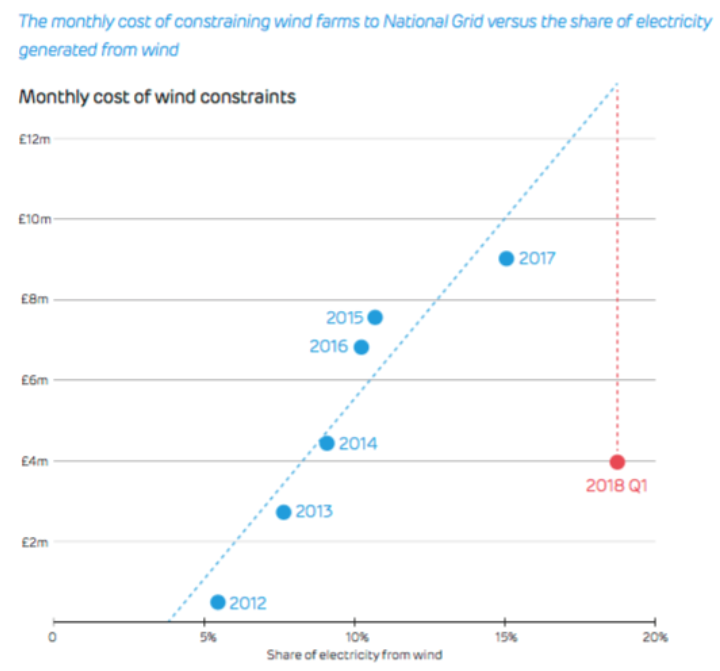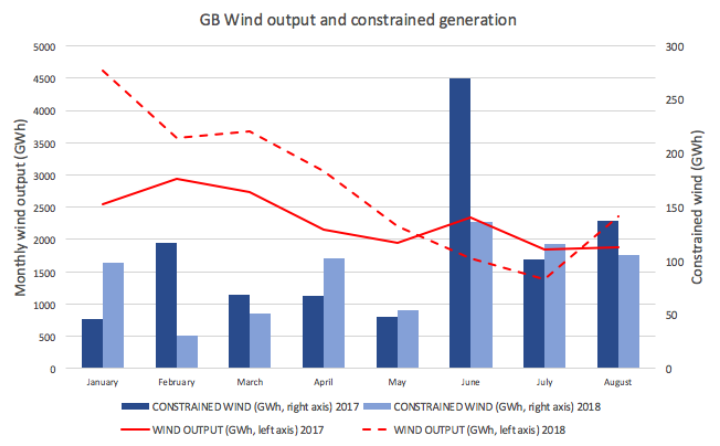Wind constraint payments - on the way down?
The latest data shows that a favourite anti-wind argument may be running out of puff
By Jonny Marshall
Share
Last updated:
As the number of arguments against the UK’s shift to a low-carbon power system fall away – with green energy now cheaper, cleaner and significantly more popular than the fossil-fuel alternative – those looking to talk down the future are left with ever-fewer arguments with which to make their point.
One final weapon in their arsenal was that of wind constraint payments, money paid to wind farm operators for them to ‘switch off’ their turbines – typically when high winds and a high concentration of wind farms means that all of the power they generate could not be transported to where it is needed.

Mainly affecting turbines in Scotland, where gusty weather conditions and government backing have led to an impressive growth in wind capacity, the issue of constraint payments has been described as a ‘racket’. One far-fetched analogy compared the situation to a sausage factory paid to stop producing sausages when its delivery lorries are full, seemingly ignoring what a business owner would do in that situation – boost the number of lorries.
Bizarre comparisons aside, the issue of constraint payments (although only adding around a pound per year to domestic energy bills) are a real issue. In a bad year, more than 5% of total GB wind generation can be spilled, representing wasted energy, wasted investment and wasted fossil fuels that are burnt instead to meet demand.
To compound the worry over wind farms ‘being paid not to run’, the cost of curtailing wind in the UK has been increasing as capacity has grown, topping £100 million in 2017 for the first time. Although only ever imagined as a temporary issue (until the market developed suitable flexibility mechanisms to avoid wasting electricity), the seemingly unstoppable rise has attracted media attention.
Peaked?
But now, to the indignation of those peddling press releases to highlight these figures, the cost of wind curtailment is showing signs of falling, despite the UK generating more electricity from wind with each passing year. Further, the rapid developments in balancing technologies mean that the end of the problem could even be described as ‘in sight’.
First highlighted by Imperial College researchers earlier in the year, curtailment costs have fallen off a cliff during 2018. This plummet follows the opening of the first part of a 2 GW HVDC link between Scotland and England, providing much-needed relief on the main bottleneck that stopped all of the power generated north of the border being transmitted south.
In the first quarter, wind curtailment in 2018 was down by around two-thirds compared with the average over recent years, a direct result of the new link allowing electricity to flow from Scottish wind turbines to demand centres further south.

So far, so good. But lower summer demand means that payments can be higher in the middle of the year. Using the latest Elexon data, however, numbers from the summer correlate with those from the first quarter of the year, and further support the hypothesis that constraint payments may have peaked.
During the first eight months of the year, total GB constraint payments were 17% (nearly £10 million) lower than in the same period last year. Just 3% of wind generation was curtailed during January-August 2018, compared with more than 4.5% in the same period last year, data downloaded from National Grid shows.
And while the ‘wind drought’ seen during the scorching summer of 2018 pushed down wind output in July, the UK’s windfarms still generated 22% more power in the first eight months of 2018 than in 2017.
Barring an unexpected surge in the rest of the year, this inflection point could represent the beginning of the eradication of constraint payments – saving money, cutting waste and reducing emissions.

Progress
But a small change is just that. £50 million over eight months is still a considerable sum of money, and one that could surely be put to better use.
Not only does the current value need to continue falling, it needs to do so in the face of rising wind generation (meeting the UK’s carbon budgets will require at least 45-55% of electricity to be from renewables in 2030).
This will require more than new connection capacity, which – while an effective means of slashing curtailment – is one of the more expensive means of doing so.
Alternatives and sidekicks for these new wires are improvements in forecasting, allowing mismatches between expected and actual generation to be reduced. This cuts the need for tinkering in the balancing market – the mechanism through which system operators keep the grid in check by fine-tuning the amount of power flowing into the network.
Increased system integration will also cut costs. New interconnectors to foreign lands can see excess wind power used to boil German kettles, to charge Irish electric vehicles, or even to fill Norwegian pumped hydro plants that can feed the power back into the system later when it is needed more.
The benefits of grid integration are evident in real-world data, with constraints in highly-interconnected EU states far lower than in the islanded GB grid.
And on top of these ‘established’ methods of increasing grid flexibility, new technologies such as blockchain could be used to cut wastage – as is being tried by Centrica – at potentially lower cost.
Overall, the message is clear; the UK’s grid is evolving to manage an ever-greater share of renewables, and as it does, out-of-date arguments about the system's inability to cope with them crumble further.
Share